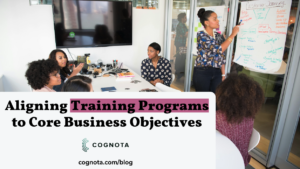Though instructional designers follow tried-and-true models and processes to build courses, the complexities of today’s work environment often wreak havoc on the most disciplined approaches.
As such, to ensure that all stakeholders get a good idea of how the learning course will turn out right at the outset, instructional designers should consider rapid prototyping.
Rapid prototyping is an instructional design approach that combines the design, developmental, and evaluation phases of the ADDIE model. The idea is to produce and present a sample working model that is a scaled-down representative version of the whole course.
A primary goal of the prototype is to provide a general understanding of what the course will look like and how it will work. It is created to test the instructional efficacy and/or usability of concepts or processes, such as the user experience and navigational framework before the actual course is built.
Rapid prototyping overcomes the challenges of the conventional ADDIE practices by enabling stakeholders to peek into the course and provide feedback that the designers can implement without needing to worry about redoing the course. This prevents headaches and confusion at the end, saving valuable time and ensuring that learners receive training faster.
Prototyping is actually a common practice in the software engineering field. Front-end Web designers will first create mockups or wireframes of what the webpage or app will look like, often with several versions to give stakeholders a chance to provide feedback before coding begins. Similarly, back-end software engineers will create tests first before writing the code to ensure that the app will perform the right functions in the correct order, with expected outcomes.
The Case for Rapid Prototyping
Besides being cost- and time-efficient, rapid prototyping delivers these additional benefits:
Creativity: Even the most seasoned instructional designer can run out of ideas. Presenting a prototype to stakeholders early on can jumpstart creativity and inspire elements of the course design.
Stronger communications channels: Because the rapid prototyping process allows for various stakeholders to interact early on in the course development process, many stakeholders find opportunities to connect with one another. This establishes the feedback loop and more importantly, trust.
Download our eBook to learn how Instructional Designers can scale design efforts.
When Should You Do Rapid Prototyping
When the course content is very complex: This is a no-brainer. It’s best to create a rough sketch or “lighter” version of the course to ensure that the course does not get even more complex that it already is. Additionally, subject matter experts’ time is valuable, and you do not want to waste their time (and your budget) having them re-work course content later on.
When the “look and feel” of the course is extremely important: This is similar to the previous point: perhaps the design or user experience (UX) is itself also complex, requiring intricate animations and HD video. Address these complexities early on before the creative team is engaged. Like subject matter experts, graphic designers, animators, and video editors are expensive.
When you have a suspicion that stakeholders will be finicky: As an instructional designer, you deal with several different personalities, and with your project management skills, you need to be as predictive as possible. If you have strong feelings that your project stakeholders will reject your ideas and change their minds frequently, it’s best to deliver a prototype first and document their perceptions and feedback before the creation of the course. This will save much pain later on.
What Makes a Perfect Prototype?
Fast turnaround: It’s called rapid prototyping for a reason — it should be created quickly. If you find yourself spending too much time creating the prototype, then you might be overthinking it.
Leaves room for failure: The most effective prototypes encourage queries and dialogue. You should want your stakeholders to ask questions like, “Couldn’t this be done in another way?” and “Why did you feel the need to do XYZ?” End-user feedback, queries, and recommendations help you design a meaningful course that is inclusive of various opinions and viewpoints.
Vigorous discourse when presenting the prototype is exactly what you need to ensure the smooth transition to building the actual course. The discoveries you make as stakeholders provide feedback on the prototype can only help you build an even better course and deliver an even more effective learning experience.
Do you currently do rapid prototyping when building courses? What tools or platforms do you use to carry this out? We would love to hear from you.





